| C.III and C.V | |
|---|---|
 | |
| Role | Reconnaissance aircraft |
| National origin | Germany |
| Manufacturer | Rumpler |
| First flight | 1916 |
The Rumpler C.III (factory designation 6A 5) was a biplane military reconnaissance aircraft built in Germany during World War I. [1]
| C.III and C.V | |
|---|---|
 | |
| Role | Reconnaissance aircraft |
| National origin | Germany |
| Manufacturer | Rumpler |
| First flight | 1916 |
The Rumpler C.III (factory designation 6A 5) was a biplane military reconnaissance aircraft built in Germany during World War I. [1]

It was a development of the Rumpler C.I design incorporating many aerodynamic refinements, including wing planform, airfoil section, and horn-balanced ailerons, [2] revised empennage, [2] and new rear fuselage decking with compound curves. [3] This latter feature was later removed and replaced with a simplified structure, at which point the factory designation was changed to 6A 6. [3] Performance was improved over that of the C.I, [1] and the C.III was selected for limited production, thought to be about 75 aircraft. The Frontbestand table of C-type aircraft at the front shows a maximum of 42 C.III aircraft at the front on 28 February 1917. With the introduction of the more powerful Rumpler C.IV based on a refined C.III airframe, the number of operational C.III aircraft at the front dropped rapidly and by the autumn of 1917 only one was at the front. The C.III was a qualified success, but its design served mainly as a stepping stone to the further refined C.IV. [2]
Data from Kroschel & Stützer 1994, p.127
General characteristics
Performance
Armament
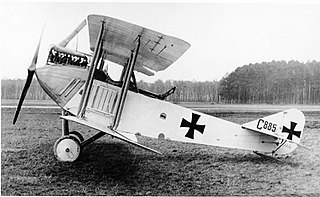
The AEG C.II was a German two-seat biplane reconnaissance aircraft produced in small numbers from October 1915. It was a slightly smaller version of the C.I with better performance, redesigned cockpit for both pilot and observer/bombardier, new rear mounting for a 7.92 mm (.312 in) Parabellum MG14 machine gun, and the ability to carry four 10 kg (22 lb) bombs for light attack duties.
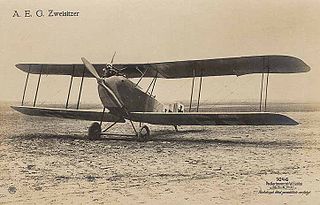
The AEG C.IV was a German two-seat biplane reconnaissance aircraft that entered service in 1916.
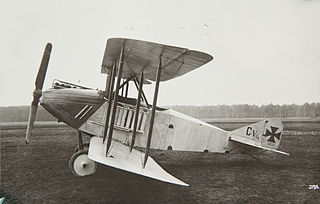
The AEG C.V was a prototype two-seat biplane reconnaissance aircraft of World War I. Designed to use a more powerful engine than previous AEG C-class reconnaissance aircraft, results were disappointing enough that further development was cancelled.

The Albatros C.III was a German two-seat general-purpose biplane of World War I, built by Albatros Flugzeugwerke. The C.III was a refined version of the successful Albatros C.I and was eventually produced in greater numbers than any other C-type Albatros.
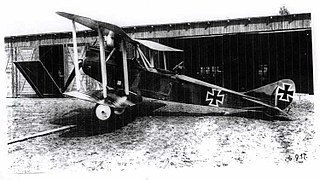
The Rumpler C.IV was a German single-engine, two-seat reconnaissance biplane. It was a development of C.III with different tail surfaces and using a Mercedes D.IVa engine in place of the C.III's Benz Bz.IV. The Rumpler 6B 2 was a single-seat floatplane fighter variant with a 120 kW (160 hp) Mercedes D.III engine built for the Kaiserliche Marine.
Numbers 467 to 470 were four examples of a unique seaplane design produced for the flying service of the Imperial German Navy during the First World War. These four aircraft were the subject of an order by the Navy for trainer seaplanes for the base at Putzig, at a time when most trainers were merely obsolete front-line types.
Imperial German Navy seaplanes numbers 1105 to 1106 were the only two examples of a unique design produced for the navy's flying service during the First World War. They were unarmed biplanes of conventional configuration with staggered wings of unequal span. The empennage included a sizable ventral fin. Intended as training aircraft, the pilot and instructor sat in tandem, open cockpits. The undercarriage consisted of twin pontoons. The interplane strut arrangement was remarkable for its day, consisting of N-struts and V-struts without any rigging wires.

Imperial German Navy seaplanes 461 and 462 were the only two examples of a seaplane design produced for the Navy's flying service during the First World War. Number 461 was built in October 1916 and Number 462 in September 1917 as the German seaplane bases searched for purpose-built training aircraft to supplement their collection of retired combat types.
Imperial German Navy seaplane number 947 was a reconnaissance aircraft produced during the First World War, the sole example of its type. It was one of only three armed aircraft built by the Kaiserliche Werft Wilhelmshaven amongst a variety of trainer seaplanes that they had produced for the Navy during the course of the war. Number 947 was a two-bay biplane of conventional design, with twin pontoon undercarriage, and two open cockpits in tandem. It received the Naval classification CHFT, indicating an armed aircraft equipped with radio gear capable of both sending and receiving.

The Rumpler B.I was a military reconnaissance aircraft produced in Germany during World War I.
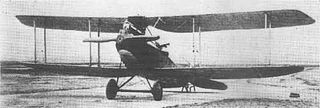
The Rumpler C.VII was a military reconnaissance aircraft built in Germany during World War I. It was developed from the C.IV and optimised for high-altitude missions that would allow it to operate at heights that would render it immune to interception by enemy fighters. Work on the C.VII took place after a similar attempt to develop the C.III into a high-altitude machine as the C.V failed.
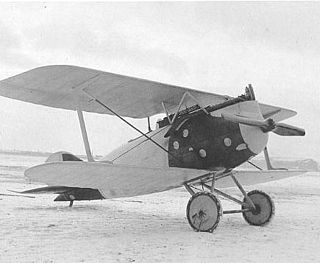
The Rumpler D.I was a fighter-reconnaissance aircraft produced in Germany at the end of World War I. It was a conventional single-bay biplane with wings of unequal span braced by I-struts. It featured an open cockpit and a fixed, tailskid undercarriage. The upper wing was fitted with aerodynamically balanced ailerons and fuselage had an oval cross-section.

The Rumpler G.I was a bomber aircraft produced in Germany during World War I, together with refined versions known as the G.II and G.III.
The Sablatnig SF-1 was a reconnaissance seaplane built in Germany during the First World War.
The Sablatnig SF-2 was a reconnaissance seaplane produced in Germany during the First World War.
The Sablatnig SF-5 was a reconnaissance seaplane produced in Germany during the First World War.

The Sablatnig SF-8 was a training seaplane produced in Germany during the First World War. While Sablatnig's previous designs for the Imperial German Navy had often seen service as trainers, the SF-8 was purpose-built for this role, at Dr Sablatnig's suggestion. The SF-8 was similar to the firm's earlier designs: a conventional two-bay biplane with staggered wings of unequal span, with open cockpits in tandem.
The Siemens-Schuckert R.III was a prototype bomber aircraft built in Germany during World War I. It was one of six aircraft based on the Siemens-Schuckert R.I that were originally intended to be identical, but which each developed in a different direction and were designated as different aircraft types by the German Inspectorate of Flying Troops. The aircraft's development was impeded by the unreliability of its Maybach HS engines, and when it was eventually accepted for military service, it was only in a training role.
The Siemens-Schuckert R.V was a bomber aircraft built in Germany during World War I. It was one of six aircraft based on the Siemens-Schuckert R.I that were originally intended to be identical, but which each developed in a different direction and were designated as different aircraft types by the German Inspectorate of Flying Troops. Development of the R.V benefited from the experience that Siemens-Schuckert and the Idflieg had gained with the R.II, R.III, and R.IV, particularly in its choice of powerplants, where the R.V was spared from the troublesome Maybach HS engine. Between September 1916 and February 1917, the aircraft saw service on the Eastern Front before it was damaged in an accident and dismantled for spare parts.

The Rumpler C.X, produced under the company designation Rumpler 8C 14, was a German two-seat observation aircraft. It was developed from the earlier Rumpler 8C 13 prototype by Rumpler in early 1918. The prototype had a similar wing design to the Rumpler C.VII, powered by a 260 hp (194 kW) Mercedes D.IVa engine and was later powered by a 240 hp (179 kW) Maybach Mb.IVa. The C.X had the highest top speed and service ceiling of all German C-type aircraft and an order was placed for the aircraft in August 1918, but few were built and tested before the war ended.